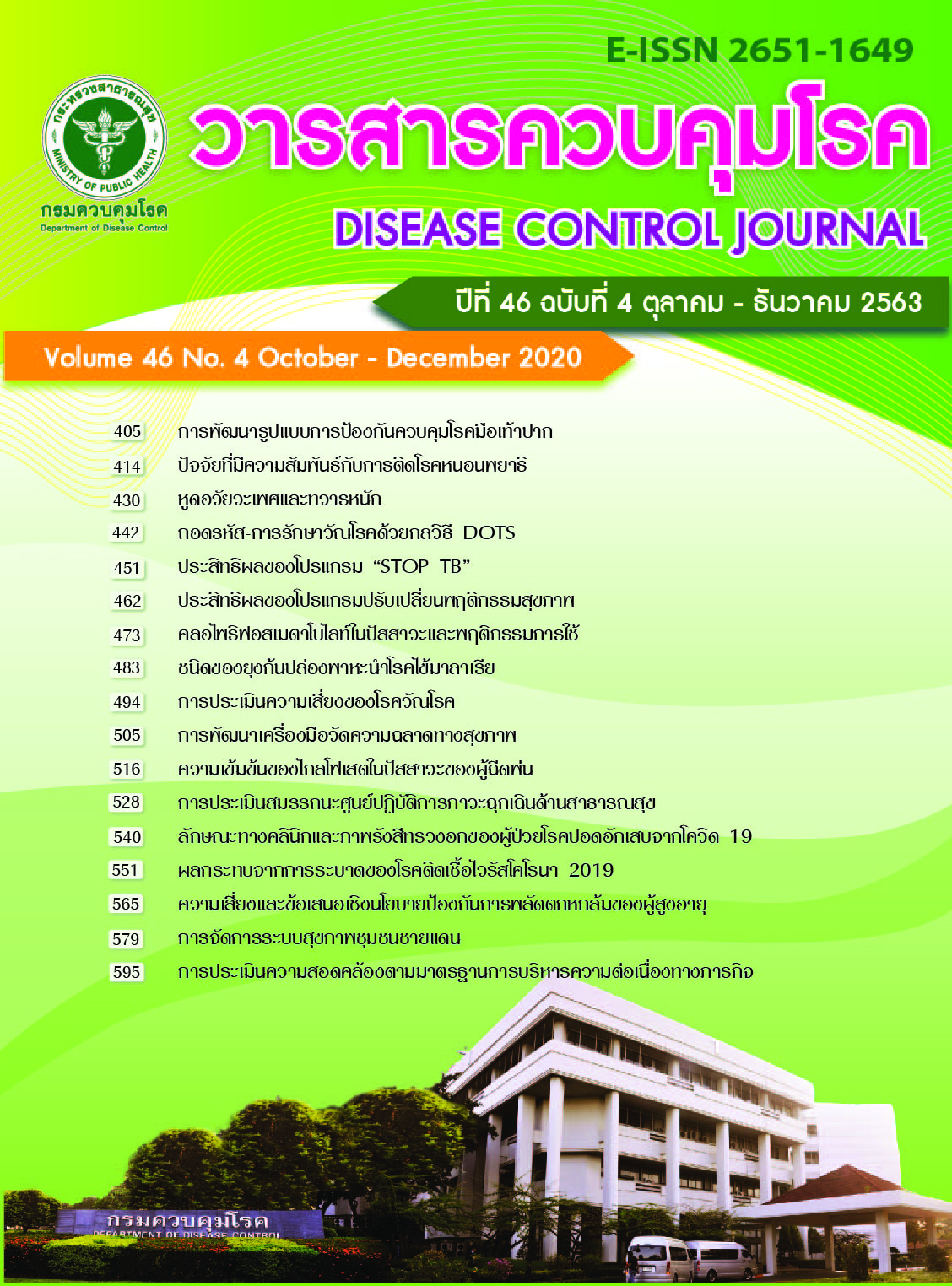Anopheles species composition in malaria high-risk areas in Ranong Province
DOI:
https://doi.org/10.14456/dcj.2020.45Keywords:
Anopheles mosquitoes, malaria, high malaria transmission areaAbstract
This survey research aimed at studying Anopheles species composition, feeding habits, trends of malaria vector, and meteorological factors in high malaria transmission areas of Ranong Province. A total of 689 adult mosquitoes were collected from two villages using human landing catch method from 06:00 PM to 06:00 AM between May and July 2017. Morphologic Identification of Anopheles mosquitoes was performed using a stereo microscope. The salivary glands’ genomic DNA of Anopheles mosquitoes were individually examined for the infection with malarial parasites by polymerase chain reaction. Data were analyzed using descriptive statistics. The research results regarding diversity and feeding habits showed five Anopheles species including Anopheles dirus complex (52%), Anopheles minimus complex (44.67%), Anopheles maculatus complex (0.33%), Anopheles barbirostris/campestris (0.33%), and Anopheles umbrosus group (2.67%). An. dirus complex and An. minimus complex were found in every month throughout the study period and throughout the night. An. maculatus complex were merely found in June, while An. barbirostris/campestris was found only in May. An. umbrosus group was found in June and May and during the first half of the night (06:00 PM-12:00 PM). None of salivary glands’ genomic DNA Anopheles mosquito were positive with PCR for Plasmodium spp. parasites. Relative humidity and temperature did not affect the density of all Anopheles. The increased rainfall was associated with a decrease in the number of Anopheline mosquitoes. Increasing in rainfall had negative impact on the density of An. barbirostris and An. Campestris to the extent that these two mosquito species could no longer be collected. Nonetheless, the increase in rainfall was found to have less impact on An. maculatus complex. Research findings of this study can be applied for effective surveillance, prevention and control of malaria.
Downloads
References
Thai Health Promotion Foundation. Malaria kills 1 million people a year in the world [Internet]. [cited 2019 Apr 2]. Available from: https://www.thaihealth.or.th/Content/4021- Malaria kills 1 million people a year in the world.html (in Thai)
Bureau of Epidemiology. Malaria [Internet]. Nonthaburi: Department of Disease Control, Ministry of Public Health; 2561 [cited 2019 Apr 2]. 1 p. Available from: https://ddc.moph.go.th/disease_detail.php?d=17 (in Thai)
Bureau of Vector-Borne Diseases. Thailand malaria elimination program [Internet]. 2560 [cited 2017 Sep 14]. Available from: http://203.157.41.215/malariaR10/index_newversion.php# (in Thai)
World Health Organization. Malaria Elimination in the Greater Mekong Subregion (GMS) [Internet]. [cited 2020 Mar 18]. Available from: https://www.who.int/malaria/mpac/mpac-april2019-session4-mekong-elimination-presentation.pdf?ua=1
Denise M, Verena I, Sasithon P, Rose Mc, Francois H. Malaria ecology along the Thailand – Myanmar border. PMC [Internet]. 2015 [cited 2015 Oct 5];14:388. Available from: http://www.ncbi.nlm.nih.gov/pmc/articles/PMC4594738/
Rattanarithikul R, Harrison BA, Harbach RE, Panthusiri P. Illustrated key to the mosquitoes of Thailand IV. Anopheles. Southeast Asian J Trop Med Public Health 2006;37:1-128.
Doolan DL. Malaria methods and protocols. New Jersey: Humana Press; 2002. P. 189-203.
Thai Meteorological, Department Automatic Weather System. Weather classified by city [Internet]. 2008 [cited 2019 Jan 23]. Available from: http://www.aws-observation.tmd.go.th/web/main/index.asp
Centers for Disease Control and Prevention. Malaria [Internet]. [cited 2020 Mar 26]. Available from: https://www.cdc.gov/malaria/about/biology/#tabs-1-5
Amsakul S, Yotmek S, Pinyorattanachot A, Sukra K, Petchchan D, Weurnprakone P, et al. Infection rate of Plasmodium knowlesi in anopheles vectors, humans, monkeys and langurs in upper region of southern Thailand. Nonthaburi: Department of Disease Control; 2010. (in Thai)
Sriwichai P, Samung Y, Sumruayphol S, Sumruayphol S, Kiattibutr K, Kumpitak C, et al. Human Plasmodium infections in major Anopheles mosquitoes in western Thailand. Parasite Vectors 2016;9:17.
Tainchum K, Ritthison W, Chuaycharoensuk T, Michael J, Manguin S, Chareonviriyaphap T. Diversity of Anopheles species and trophic behavior of putative malaria vector in two malaria endemic areas of northwestern Thailand. J Vector Ecol 2014;39:424-36.
Kwansombon N, Chaumeau V, Kittiphanakun P, Cerqueire D, Corbel V, Chareonviriyaphap T. Vector bionomics and malaria transmission along the Thailand – Myanmar border:a baseline entomological survey J Vector Ecol 2017;42:84-93.
Tananchai C, Tisgratog R, Juntarajumnong W, Grieco JP, Manguin S, Prabaripai A, et al. Species diversity and biting activity of Anopheles dirus and Anopheles baimaii (Diptera: Culicidae) in a malaria prone area of western Thailand. Parasit Vectors 2012,5:211.
Beck-Johnson LM, Nelson WA, Paaijmans KP, Read AF, Thomas MB, Bjørnstad ON. The effect of temperature on Anopheles mosquito population dynamics and the potential for malaria transmission. PLoS One 2013;8:11.
Bayoh MN, Lindsay SW. Temperature-related duration of aquatic stages of the Afrotropical malaria vector mosquito Anopheles gambiae in the laboratory. Med Vet Entomol 2004;18:174-9.
Pratt HD, Moor CG. Mosquitoes of public health importance and their control. Atlanta: Centers for Disease Control and Prevention; 1993. 55 p.
Yamana TK, Eltahir EA. Incorporating the effects of humidity in a mechanistic model of Anopheles gambiae mosquito population dynamics in the Sahel region of Africa. Parasit Vectors 2013;6:235.
Rosenberg R: Forest malaria in Bangladesh. III. Breeding habits of Anopheles dirus. Am J Trop Med Hyg 1982;31:192-201.
Valerie O, Pierre D, Marc C. Predicted Distribution of Major Malaria Vectors Belonging to the Anopheles dirus Complex in Asia: Ecological Niche and Environmental Influences. PLoS One 2012;7:11.
Plianbangchang S. Anopheline Species Complexes in South and South-East Asia. World Health Organization; 1998.22.
Tananchai C, Tisgratog R, Juntarajumnong W, Grieco JP, Manguin S, Prabaripai A, et al. Species diversity and biting activity of Anopheles dirus and Anopheles baimaii (Diptera: Culicidae) in a malaria prone area of western Thailand. Parasites & Vectors [Internet]. 2012 [cited 2020 Mar 26]. Available from: https://parasitesandvectors.biomedcentral.com/articles/10.1186/1756-3305-5-211
Downloads
Published
How to Cite
Issue
Section
License
Articles published in the Disease Control Journal are considered as academic work, research or analysis of the personal opinion of the authors, not the opinion of the Thailand Department of Disease Control or editorial team. The authors must be responsible for their articles.






